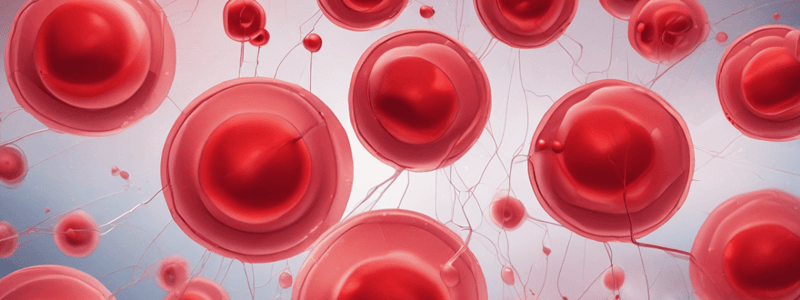Podcast
Questions and Answers
What is the preservative solution used to store red blood cells?
What is the preservative solution used to store red blood cells?
- Anticoagulant
- Saline solution
- Adenine solution
- CPDA-1 (correct)
Red cells lose intracellular 2,3-diphosphoglycerate (2,3-DPG) during storage.
Red cells lose intracellular 2,3-diphosphoglycerate (2,3-DPG) during storage.
True (A)
What is the maximum allowable storage time for red blood cells?
What is the maximum allowable storage time for red blood cells?
35 days
Platelet concentrates must contain at least __ platelets per unit.
Platelet concentrates must contain at least __ platelets per unit.
Match the components with their descriptions:
Match the components with their descriptions:
How long can frozen RBCs be stored in mechanical freezers or liquid nitrogen?
How long can frozen RBCs be stored in mechanical freezers or liquid nitrogen?
At what temperature are frozen units of RBCs thawed rapidly?
At what temperature are frozen units of RBCs thawed rapidly?
Failure to properly deglycerolize frozen RBCs can result in hemolysis.
Failure to properly deglycerolize frozen RBCs can result in hemolysis.
After deglycerolization, red cells can be stored for up to 1 day at 1°C to 6°C if processed by an ______ method.
After deglycerolization, red cells can be stored for up to 1 day at 1°C to 6°C if processed by an ______ method.
Match the following terms with their descriptions:
Match the following terms with their descriptions:
What is the primary function of component manufacture?
What is the primary function of component manufacture?
Blood transfusion with RBCs that have been stored for too long can lead to hyperkalemia.
Blood transfusion with RBCs that have been stored for too long can lead to hyperkalemia.
What is the maximum allowable storage time for RBCs?
What is the maximum allowable storage time for RBCs?
Platelet concentrates must contain at least _ platelets per unit.
Platelet concentrates must contain at least _ platelets per unit.
Match the blood component with its primary function:
Match the blood component with its primary function:
How long can frozen RBCs be stored in mechanical freezers or liquid nitrogen?
How long can frozen RBCs be stored in mechanical freezers or liquid nitrogen?
At what temperature are frozen units of RBCs rapidly thawed?
At what temperature are frozen units of RBCs rapidly thawed?
Failure to properly deglycerolize frozen RBCs can result in ___.
Failure to properly deglycerolize frozen RBCs can result in ___.
Washing of platelets can result in clumping and activation with reduced viability.
Washing of platelets can result in clumping and activation with reduced viability.
Match the following terms with their definitions:
Match the following terms with their definitions:
Flashcards are hidden until you start studying
Study Notes
Blood Component Manufacture
- Whole-blood donations are manufactured into components to facilitate treatment of different patients with requirements for RBCs, plasma, or platelets.
- Goals of component manufacture are to maintain viability and function, and to prevent detrimental changes or contamination of desired constituents.
Red Blood Cells (RBCs)
- RBCs are prepared from whole blood by centrifugation and removal of plasma and platelets.
- RBCs can be stored for up to 35 days at 1°C to 6°C in the preservative solution CPDA-1, supplemented with dextrose and adenine.
- Additive solutions containing glucose and other substrates can be added during manufacture, allowing for longer storage periods (42 days) and lower hematocrit (Hct).
- During storage, red cells undergo senescence changes, and a portion of transfused red cells are rapidly cleared by the spleen.
- Maximum allowable storage time for RBCs is defined by the requirement for recovery of 75% of transfused cells 24 hours after transfusion.
- Leakage of intracellular potassium occurs during red cell storage due to lack of ATP to fuel the potassium pump.
- Hypokalemia may occur secondary to RBC transfusion due to influx of potassium into transfused RBCs.
Plasma
- Plasma is separated from whole blood and frozen for extended preservation.
- Fresh frozen plasma (FFP) is separated from RBCs and frozen at -18°C within 8 hours of collection.
- FFP can be stored for up to 1 year at -18°C or lower.
- Thawed plasma not used within 24 hours can be relabeled as "thawed plasma" and stored for up to 5 days at refrigerator temperatures.
Cryoprecipitated Antihemophilic Factor (Cryoprecipitate)
- Cryoprecipitate is the cold insoluble portion of plasma remaining after FFP has been thawed at refrigerator temperatures.
- It contains approximately 50% of factor VIII and 20% to 40% of the fibrinogen present in the original plasma unit.
- Cryoprecipitate also contains von Willebrand factor (vWF) and factor XIII.
Platelet Concentrates (PCs)
- PCs are prepared from whole blood by centrifugation of platelet-rich plasma and removal of platelet-poor plasma.
- PCs must contain at least 5.5 × 10^10 platelets per unit.
- PCs are stored at room temperature (20°C--24°C) with continuous gentle agitation to encourage gas exchange.
- PCs can be stored for up to 5 days.
- PCs typically contain a small number of red cells, which can cause alloimmunization to red cell antigens.
- PCs can be pooled using an open system or a system that maintains sterility, often referred to as "prepooled platelets".
Leukocyte Components
- Granulocytes can be prepared by apheresis and stored at room temperature for up to 24 hours.
- Granulocytes may have reduced ability to circulate and migrate to areas of inflammation after even brief in vitro storage.
- Mononuclear cells collected by apheresis can be a source of hematopoietic progenitor cells (HPCs) for autologous or allogeneic transplantation.
- HPCs can be stored frozen after addition of a cryoprotective agent, such as dimethylsulfoxide (DMSO), for an extended period of time.
Leukocyte-Reduced Blood Components
- Leukocytes present in blood components can cause adverse effects, including febrile nonhemolytic transfusion reactions, immunization to leukocyte (particularly HLA) antigens, and transmission of leukocyte-associated viruses.
- To minimize these adverse impacts, many blood centers and transfusion services have instituted the use of leukocyte-reduced components for all transfusions.
- Leukocyte reduction is typically accomplished by filtration at the time of component manufacture (prestorage leukocyte reduction) or at the time of transfusion (poststorage leukocyte reduction).
Special Components
- Cryoprecipitate-reduced plasma (cryopoor plasma) is the supernatant remaining from the production of cryoprecipitate.
- Cryoprecipitate-reduced plasma is relatively deficient in high molecular weight forms of vWF but retains close to normal levels of the vWF-cleaving metalloprotease ADAMTS 13.
- RBCs can be stored in the frozen state after addition of a cryoprotective agent, such as glycerol.
- Frozen RBCs can be stored in mechanical freezers or liquid nitrogen for up to 10 years.
- Frozen units are thawed rapidly at 37°C, and the cryoprotective agent must be removed by progressive addition of washing solutions with decreasing osmolality.
Blood Component Manufacture
- Whole-blood donations are manufactured into components to treat different patients with requirements for RBCs, plasma, or platelets.
- Goals of component manufacture:
- Maintain viability and function
- Prevent detrimental changes or contamination of desired constituents
Red Blood Cells (RBCs)
- Prepared from whole blood by centrifugation and removal of plasma and platelets
- Stored in preservative solution CPDA-1 with dextrose and adenine to preserve red cell ATP levels
- Can be stored for up to 35 days at 1°C to 6°C
- Additive solutions containing glucose and other substrates permit longer storage period (42 days) and have a lower hematocrit (Hct)
- Red cells undergo senescence changes during storage, similar to aging in vivo
- Maximum allowable storage time defined by requirement for recovery of 75% of transfused cells 24 hours after transfusion
- Leakage of intracellular potassium occurs during red cell storage due to lack of ATP to fuel the potassium pump
Plasma
- Separated from whole blood and frozen for extended preservation
- Loss of labile clotting factors, particularly factor VIII and factor V, occurs in liquid state at refrigerator temperatures
- Fresh frozen plasma (FFP) is separated from RBCs and frozen at -18°C within 8 hours of collection
- Coagulation factor content of FFP, FP24, or PF24RT24 is essentially equivalent
- Frozen plasma may be stored for up to 1 year at -18°C or lower
- Thawed plasma must be transfused within 24 hours
Cryoprecipitated Antihemophilic Factor (Cryo)
- Cold insoluble portion of plasma remaining after FFP has been thawed at refrigerator temperatures
- Contains approximately 50% of factor VIII and 20% to 40% of the fibrinogen present in the original plasma unit
- Also contains von Willebrand factor (vWF) and factor XIII
- FDA regulations require a unit of cryoprecipitate to contain at least 80 IU of factor VIII
Platelet Concentrates (PCs)
- Prepared from whole blood by centrifugation of platelet-rich plasma and removal of platelet-poor plasma
- Must contain at least 5.5 × 10^10 platelets per unit
- Stored at room temperature (20°C--24°C) because platelets stored at refrigerator temperature (1°C--6°C) have greatly diminished posttransfusion survival
- Allowable storage time is up to 5 days with continuous gentle agitation to encourage gas exchange
- pH of PCs must be 6.0 or higher at the end of storage
- PCs contain a small number of RBCs, which can cause alloimmunization to red cell antigens
- PCs contain 30 to 50 mL of plasma
- Typically necessary to pool five or more PCs to obtain a therapeutic dose for a typical adult patient (3.0 × 10^11 platelets)
Leukocyte Components
- Granulocytes can be prepared by apheresis
- Stored at room temperature for up to 24 hours
- Desirable to transfuse as soon as possible after collection
- Donor stimulation with granulocyte colony-stimulating factor (G-CSF) is usually necessary to obtain a sufficient number of granulocytes for a therapeutic dose
- Granulocyte units contain a substantial number of RBCs and must be ABO compatible with the recipient
- Mononuclear cells collected by apheresis can be a source of hematopoietic progenitor cells (HPCs) for autologous or allogeneic transplantation
Leukocyte-Reduced Blood Components
- Leukocytes present in blood components can cause adverse effects
- Leukocyte reduction can minimize untoward effects
- Blood components must be prepared by a method known to reduce the total number of residual leukocytes to fewer than 5 × 10^6 per unit for RBCs and fewer than 8.3 × 10^5 for whole blood--derived PCs
- Leukocyte reduction can be accomplished by filtration at the time of component manufacture (prestorage leukocyte reduction) or at the time of transfusion (poststorage leukocyte reduction)
Special Components
- Cryoprecipitate-reduced plasma (cryopoor plasma) is the supernatant remaining from the production of cryoprecipitate
- Relatively deficient in high molecular weight forms of vWF but retains close to normal levels of the vWF-cleaving metalloprotease ADAMTS 13
- Can be used as an alternative to FFP for the treatment of patients with thrombotic thrombocytopenic purpura (TTP)
Preserved Red Blood Cells
- RBCs can be stored in the frozen state after addition of a cryoprotective agent, such as glycerol
- Frozen RBCs can be stored in mechanical freezers or liquid nitrogen for up to 10 years
- Frozen units are thawed rapidly at 37°C
- Cryoprotective agent must be removed by progressive addition of washing solutions with decreasing osmolality
Studying That Suits You
Use AI to generate personalized quizzes and flashcards to suit your learning preferences.




